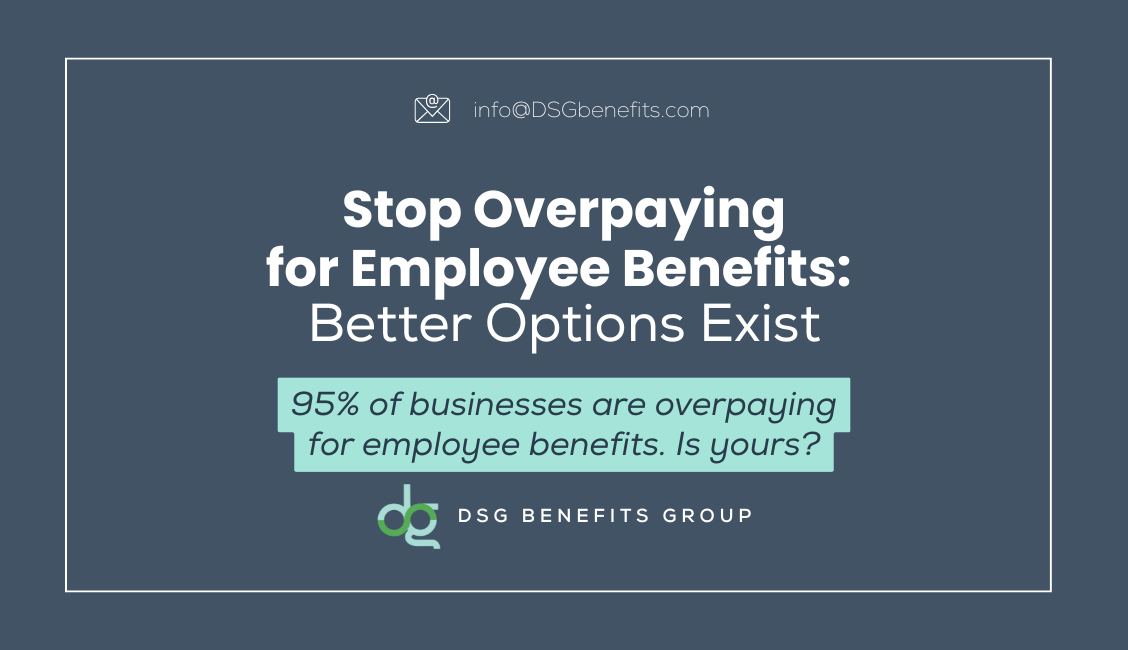Employee benefits represent one of the top three budget items for most companies, yet many businesses continue overpaying year after year. At DSG Benefits Group, we’ve seen firsthand how traditional benefits approaches fail employers and their teams. Let’s break down what’s really happening and what you can do about it.
The Problem with Traditional Employee Benefits
Budget increases and financial instability around health plans create major headaches for employers. Planning becomes nearly impossible with persistently large premium increases, while compliance requirements (ACA, FLSA, HIPAA, COBRA, PCORI) add complexity and costs.
According to industry data, most employers face these common issues:
- Rising premiums that outpace wage growth
- Cookie-cutter solutions that don’t match workforce needs
- Brokers who take the easy route rather than designing custom plans
- Limited visibility into actual healthcare spending
- Misaligned incentives between brokers and employers
The Data Shows It’s Time for Change
As DSG Benefits explains, “Over the past 20 years, premiums have been increasing faster than wages… Call it what you want to – insanity, unsustainable, etc.”
This isn’t just frustrating—it’s financially damaging. Many businesses are trapped in a cycle where:
- They receive yearly premium increases
- They shift costs to employees through higher deductibles
- They switch carriers hoping for better rates
- The cycle repeats
Understanding Your Options: Past Fully-Insured Plans
Most small businesses use fully-insured plans where “you’re paying a fixed dollar amount every single month… you’re prepaying for insurance on maybe something will occur to one of my employees in this population, very expensive line item, anywhere from 500 to $1,500 a month depending on the coverage.”
But there are better alternatives:
Level-Funded Plans
With a level-funded approach, “I’m going to pay a certain amount in fixed cost every single month and then the second half of my payment is going to go into a claims bucket. And if my plan runs well, if my population remains healthy… I’m able to drive healthy habits.”
Self-Funded Model
In a fully self-funded model, “you have complete control of the plan and you pay for something called stop loss for reinsurance. But you are driving a population to a healthier habit and you are paying out claims as they are incurred. So no reason to prepay for the what ifs.”
Addressing Common Concerns About Self-Funding
Many employers worry about catastrophic claims like organ transplants or serious diagnoses. However, there are simple protections:
For example, an “organ transplant benefit…doesn’t cost more than $10 to $15 a month per employee per month. That covers the entire cost of any type…so it doesn’t blow up the plans.”
Additionally, “reinsurance on self-funded plans is if I have any individual that spends more than $50,000 as an example, $50,000 in healthcare costs, I am buying reinsurance to now reimburse me for dollars that exceed that amount.”
Smart Benefits Design for Today’s Workforce
Today’s employees have diverse needs. As noted in one post, “Gen Z does not want the same, traditional benefits that Baby Boomers… You need to be able to properly communicate, engage and educate your dynamic workforce using different channels.”
Effective benefits strategies include:
- Employee feedback systems that gather input at least annually
- Custom-tailored plans instead of one-size-fits-all approaches
- Multiple communication channels that reach various generations
- Incentives for healthy behaviors like preventive care and generic medications
HSAs: A Tax-Advantaged Tool Many Employers Overlook
Health Savings Accounts represent “the only legal way where you can avoid taxes. Three different areas, put dollars in pre-tax. Those funds can grow tax-free in a variety of different investment choices. Then you can disperse those dollars on eligible expenses tax-free.”
They also provide long-term benefits: “When I am of Medicare age, I’m able to use those dollars to pay for those expenses. And it’s a huge plus from a retirement perspective, from a financial planning perspective.”
Why Most Benefits Advisors Don’t Show You These Options
As one insider post reveals, “that is one of MANY crazy stories of how employers react once they know what they didn’t know….”
Many advisors fall into at least one of these categories:
- “LAZY – most people in our space push the EASY button – spreadsheet, cost-shift, change carriers, etc.”
- “GREEDY – even more people in our space push products and services that are in their own best interest rather than working in the best interest of the employer”
- Lacking understanding of the market and unwilling “to roll up their sleeves to do the work”
Finding the Right Partner
When selecting a benefits advisor, look for someone who:
Focuses on objective benefits consulting, marketing strategies, ongoing management, and performance reviews
Takes time to learn your organizational objectives, analyze your demographics, and recommend strategies for maximum impact
Optimizes risk management, stabilizes insurance costs, and engages business owners and key employees
Next Steps for Employers
If you’re ready to stop overpaying for employee benefits:
- Request your data – You deserve to see exactly what you’re spending and why
- Question your advisor – Ask why they haven’t shown you alternative funding options
- Consider your workforce – Evaluate whether your current benefits match what your employees actually need
- Look beyond premium increases – Understand how plan design affects both costs and employee satisfaction
The traditional healthcare system is broken, but employers don’t have to accept the status quo. By working with advisors who prioritize transparency and custom solutions, companies can create sustainable benefits programs that control costs while supporting employees.
Remember: employee benefits represent one of your largest budget items. Isn’t it time you applied the same strategic thinking to benefits that you do to other major business decisions?

